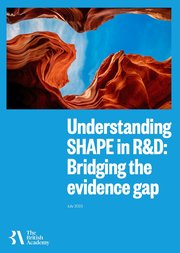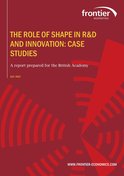Understanding SHAPE in R&D: bridging the evidence gap

- Year
- 2023
- Number of pages
- 15
Summary
The Understanding SHAPE in R&D policy synthesis represents a culmination of long-term research conducted by the Academy on research & development (R&D). This research has highlighted several key issues, not least the exclusion of SHAPE (Social Sciences, Humanities and Arts for People and the Economy) R&D from official statistics, and the possible impact of this exclusion on our understanding of the full breadth of the evidence base related to R&D. As a result, our most recent research endeavours have focussed on a central issue: “How well do we understand SHAPE R&D in the UK?”.
Answering this question has required research and analysis on UK data collection and survey instruments; on business understanding of R&D and innovation activities and variations by sector; and on international comparisons of the UK’s approach to R&D. This evidence synthesis collates that work and finds that there is a significant risk that UK policy does not accurately reflect the R&D activities which take place, and therefore may be less effective than desired in supporting the government’s goal of becoming a ‘science and technology superpower’ by 2030.
The evidence collated here, covered in more detail in the accompanying reports from Frontier Economics and RAND Europe, sets out the evidence to illustrate why a gulf between R&D activities and policy may be occurring, how we might overcome it, and to what end. We hope it is of value to policymakers and analysts of R&D and innovation who are interested in understanding how more effective policies and initiatives can be developed to support the research and innovation system. The analysis and policy insights set out here are not intended to make the argument that one set of disciplines make a greater or lesser contribution to R&D over any other. Instead, they highlight the gaps in our current systems of measuring R&D and the implications this might have for ensuring that our policies are creating the most effective research and innovation system possible.
Policy goals and recommendations
1. Obtain a full and accurate picture of the R&D evidence base across all sectors and disciplines
UK R&D statistics and data collection should accurately capture and measure SHAPE R&D investment and activities to provide a more effective evidence-base through which to support UK R&D activity.
2. Ensure policies appropriately recognise the role of R&D in the full innovation system
Alongside collecting better evidence, policy must also recognise that ‘formal’ R&D is only one part of business investment in innovation. We need to reflect differences between R&D and innovation processes in policy making, as they are easily conflated.
3. Utilise people-centric methods for measuring R&D
Recognising R&D as part of the full innovation system also means better understanding the role of people across innovation processes. SHAPE R&D is more likely to be embodied in human capital, rather than infrastructure or capital investment. As such, understanding the role that people play in R&D will identify the practices which support innovation and productivity and build on the evidence captured by statistics and data collection.
4. Support interdisciplinary and intersectoral skills for improved economic outcomes
People-centric measurements will also help policymakers better understand the interplay between STEM and SHAPE skills and expertise in R&D. Supporting interdisciplinary collaboration in R&D could create better business outcomes, solve skills gaps, and prepare for the future of work.
5. Create a holistic and nuanced evidence base to invest more effectively 3% or more of GDP in R&D.
The previous policy goals can help policymakers build a more holistic evidence-base for effective investment in R&D. Investing 3% or more of GDP effectively requires accurate measurements of R&D activities and people, and a systems approach with a long-term vision.
These recommendations are drawn from evidence collated from across our R&D research, including the accompanying reports from Frontier Economics and RAND Europe, and build on one another to create a holistic approach to fully understanding the contributions of all disciplines to UK R&D and innovation. The synthesis also highlights case studies which provide insight into the practicalities of innovation processes within organisations. Finally, the synthesis provides a summary of activity that outlines next steps for the British Academy in mobilising these policy recommendations.

